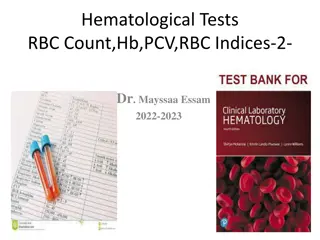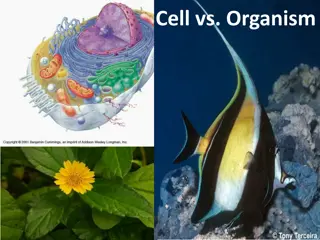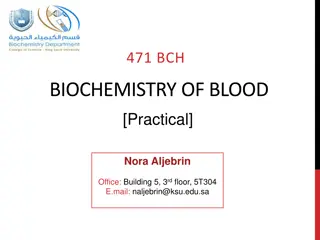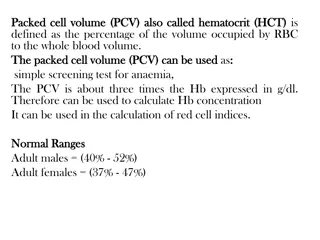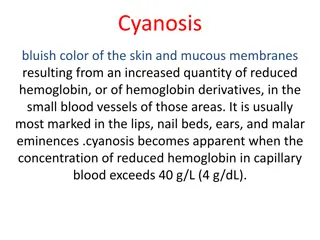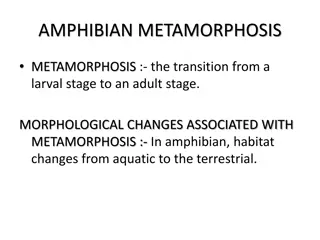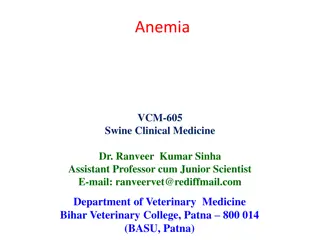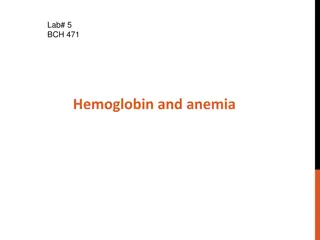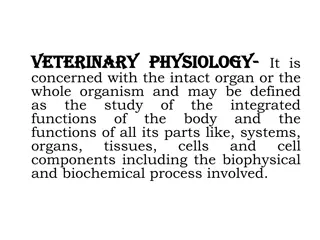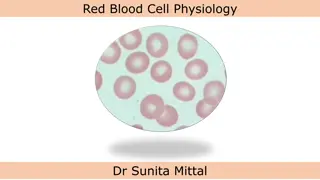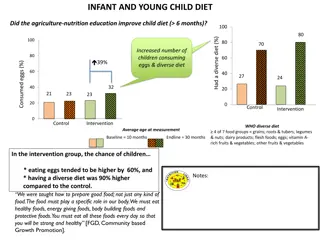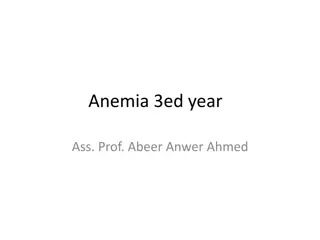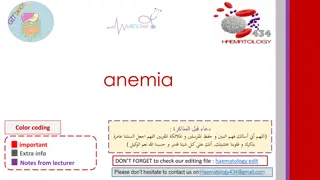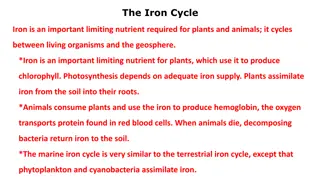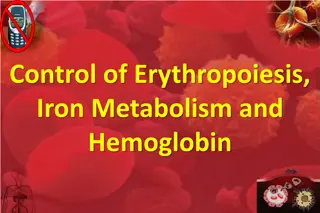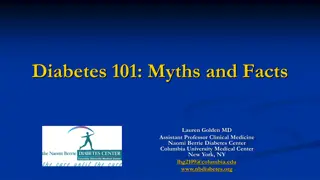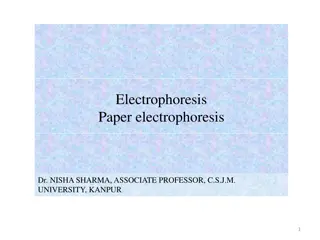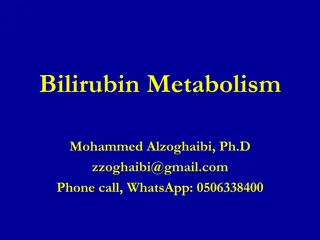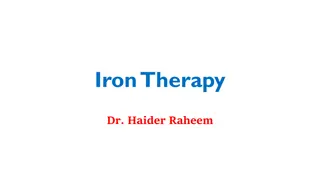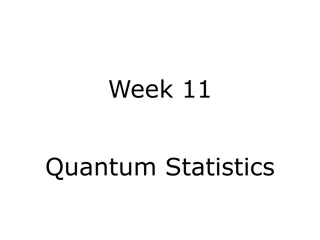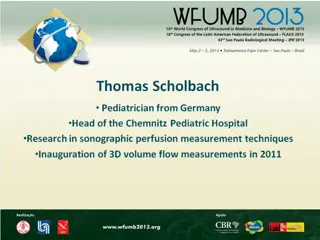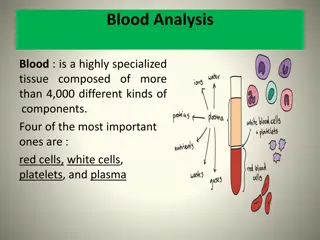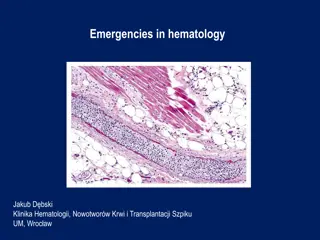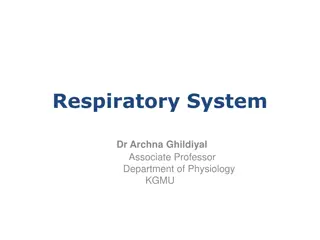Importance of Single Unit Red Blood Cell Transfusion According to Patient Blood Management Guidelines
Implementing single unit red blood cell transfusion based on patient blood management guidelines is crucial to minimize risks associated with transfusion, such as morbidity, mortality, and length of stay. By following these guidelines, healthcare providers can make informed decisions, reduce unneces
4 views • 18 slides
Understanding How Diabetes Affects Blood Vessels
Diabetes can harm blood vessels, leading to complications due to high blood sugar levels. Hemoglobin A1c plays a crucial role in monitoring glucose control, with values above 6.5% indicating diabetes. Over time, high blood sugars can damage blood vessels, affecting blood flow and increasing the risk
1 views • 19 slides
Understanding Hemoglobin Tests and Hematocrit in Blood Analysis
A hemoglobin test measures the amount of hemoglobin in the blood, which is essential for oxygen transportation in red blood cells. The test is crucial for diagnosing various health conditions, and visual methods are employed for analysis. Additionally, hematocrit, or red blood cell volume, is anothe
9 views • 23 slides
Paediatric Patients with Kidney Failure Requiring Replacement Therapy - ANZDATA Registry Insights
Explore the latest data and graphs from the ANZDATA Registry's 46th Annual Report regarding paediatric patients with kidney failure requiring replacement therapy. Discover trends in incidence, prevalence, educational participation, body mass index, hemoglobin levels, use of erythropoietic agents, fe
4 views • 35 slides
Understanding Hemoglobin: Functions, Medical Applications, and Conditions
Hemoglobin, a crucial protein in red blood cells, plays a vital role in carrying oxygen throughout the body. This article delves into its functions, detection methods, medical applications, and common conditions associated with hemoglobin, such as anemia and polycythemia. Learn about the various typ
4 views • 16 slides
Hematological Tests RBC Count,Hb,PCV,RBC Indices-2-
Hematological tests play a crucial role in assessing blood health. This guide covers the significance of RBC count, hemoglobin levels, PCV, and RBC indices. It explains the photometric technique for measuring hemoglobin, visual methods for analysis, sample hemoglobin level reference ranges, and insi
3 views • 20 slides
Understanding Clinical Features of Anemia
Clinical features of anemia include cardiovascular adaptations, variations in symptom presentation based on speed and severity of onset, implications of age, and changes in the hemoglobin-O2 dissociation curve. Symptoms may range from breathlessness and weakness to cardiac issues, while signs like p
0 views • 28 slides
Understanding Gas Exchange in Cells and Organisms
Gas exchange is vital for cellular respiration and photosynthesis. In organisms, specialized structures like alveoli in lungs and stomata in plants facilitate this process. This exchange occurs through diffusion across moist surfaces with large surface areas. In animals, oxygen is taken up by hemogl
0 views • 40 slides
Biochemistry of Blood Practical Course Overview
This biochemistry of blood practical course involves various experiments focusing on blood components such as plasma, serum, proteins, enzymes, blood groups, hemoglobin, glucose levels, and more. The course outline includes detailed experiments, marking distribution, guidelines for writing scientifi
3 views • 6 slides
Hemoglobin Estimation Using Sahli Method
Hemoglobin estimation using the Sahli method involves converting measured blood samples to acid hematin, which is then matched against colored glass rods for color intensity assessment. Normal values for males and females are provided, along with potential sources of error and conditions leading to
0 views • 40 slides
Overview of Heme Synthesis and Porphyrias
Heme is a crucial component present in various essential proteins in the body, such as hemoglobin, myoglobin, and cytochromes. The synthesis of heme takes place in multiple steps involving different organelles and enzymes in the cell. Porphyrias are a group of disorders related to heme synthesis, ch
0 views • 44 slides
Managing Diabetes in Pregnancy: Preconception and Post-conception Care
Providing preconception care for women with established type 1 or type 2 diabetes is crucial for ensuring a healthy pregnancy. This involves counseling on effective contraception, evaluating and treating diabetes-related complications, reviewing risks of uncontrolled diabetes during pregnancy, and d
0 views • 37 slides
Understanding Packed Cell Volume (PCV) and Hematocrit in Blood Testing
Packed cell volume (PCV) is a measure of the percentage of blood volume occupied by red blood cells (RBCs), used to screen for anemia and calculate hemoglobin concentration. Also known as hematocrit (HCT), it falls within specific ranges for adult males and females. The PCV is determined from venous
0 views • 5 slides
Understanding Cyanosis: Causes, Types, and Clinical Differentiation
Cyanosis is characterized by a bluish discoloration of the skin and mucous membranes due to increased levels of reduced hemoglobin. This condition can be categorized as central or peripheral cyanosis, each with distinct characteristics and causes. Central cyanosis results from decreased oxygen satur
0 views • 13 slides
Amphibian Metamorphosis: A Dive into Developmental Changes
Amphibian metamorphosis marks the transition from larval aquatic life to adult terrestrial existence. The process involves morphological transformations including tail resorption, gill destruction, and skin structure changes. Key changes in urodeles (salamanders) and anurans (frogs/toads) are outlin
1 views • 6 slides
Anemia in Swine: Causes, Clinical Signs, and Treatment
Anemia in swine can be caused by factors such as gastric ulcers, internal bleeding, and poor nutrition. Clinical signs include pale skin, rapid breathing, and jaundice. Piglet anemia, a highly fatal disease, is marked by decreased hemoglobin levels and liver degeneration. Diagnosis involves examinin
0 views • 11 slides
Understanding Hemoglobin: Synthesis, Functions, and Influence on Anemia
Hemoglobin is a vital protein in red blood cells responsible for oxygen transport. Its synthesis, influenced by factors like erythropoietin, vitamins, and trace metals, plays a crucial role in maintaining proper oxygen levels in the body. An insight into hemoglobin's structure, synthesis, and impact
3 views • 19 slides
Understanding Post-Parturient Haemoglobinuria in Dairy Cows
Post-Parturient Haemoglobinuria (PPH) is a metabolic disease affecting high-producing dairy cows after calving, characterized by hemolysis, hemoglobinuria, and anemia. Common in buffaloes and cows, it is caused by phosphorus deficiency in diet, affecting intracellular functions and leading to clinic
0 views • 9 slides
Understanding Veterinary Physiology and the Functions of Blood
Veterinary physiology involves studying the functions of intact organisms, organs, tissues, and systems. Blood, consisting of plasma and formed elements, plays vital roles in nutrient transport, gas exchange, waste removal, hormone distribution, temperature regulation, water balance, pH maintenance,
0 views • 29 slides
Red Blood Cell Physiology
Delve into the world of red blood cells (RBCs) with a focus on their morphology, functions, and hematological indices. Learn about the structure, function, and clinical applications of RBCs, as well as important indices like Mean Corpuscular Volume (MCV) and Mean Corpuscular Hemoglobin (MCH). Explor
0 views • 14 slides
Infant and Young Child Nutrition Interventions Impact on Diet and Growth
This study evaluates the impact of agriculture-nutrition education interventions on infant and young child nutrition, specifically focusing on diverse diet consumption, egg consumption, and growth indicators such as stunting and hemoglobin levels. The intervention group showed higher rates of divers
1 views • 5 slides
Understanding Hypochromic Anemias: Background, Diagnosis, and Key Findings
Anemia is characterized by a decrease in hemoglobin levels below normal, leading to various symptoms and signs. This article explores the background, definition, and causes of hypochromic anemias, along with a diagnostic algorithm and key laboratory findings essential for diagnosis. Clinical feature
1 views • 26 slides
Understanding Anemia: Key Concepts and Clinical Features
Anemia is a common condition characterized by a reduction in hemoglobin levels, leading to decreased oxygen-carrying capacity in the blood. This article delves into important aspects such as hematopoiesis, erythropoiesis, hemoglobin synthesis, and clinical manifestations of anemia. Learn about the s
0 views • 18 slides
Understanding Anemia: Causes, Symptoms, and Classification
Anemia is characterized by a reduction in hemoglobin (Hg) concentration, hematocrit (Hct) concentration, or red blood cell (RBC) count. Common symptoms include fatigue, weakness, dizziness, and palpitations. Physical signs may include pallor and tachycardia. Pica, characterized by unusual cravings,
0 views • 23 slides
The Iron Cycle and Aquatic Microbiology
Iron plays a crucial role in terrestrial and marine ecosystems, cycling between living organisms and the geosphere. It is a vital nutrient for plants, essential for chlorophyll production, and for animals, needed to create hemoglobin. The marine iron cycle involves phytoplankton and cyanobacteria as
0 views • 19 slides
Blood Transfusion Process and Implications Studied
Analyzing case studies of patients with different medical histories undergoing blood transfusions, this study examines the implications and adverse events associated with the process. It explores the use of blood transfusions in improving patient outcomes, challenges in managing hemoglobin levels, a
0 views • 31 slides
Understanding Sickle Cell Anemia: Causes, Symptoms, and Pathophysiology
Sickle cell anemia is an inherited disorder affecting red blood cells' shape, leading to decreased oxygen delivery and various symptoms like fatigue, pain episodes, and more. The condition arises from a genetic mutation affecting hemoglobin production. Individuals with sickle cell trait may not disp
0 views • 7 slides
Understanding Erythropoiesis, Iron Metabolism, and Hemoglobin Regulation
Explore the intricate control of erythropoiesis, iron metabolism, and hemoglobin synthesis in the body. Delve into the role of erythropoietin, factors influencing erythropoiesis rate, essential nutrients like iron and vitamins, and clinical conditions associated with anomalies in these processes. Ga
0 views • 25 slides
Debunking Common Myths About Diabetes
Diabetes can't be solely attributed to sugar consumption. Genetics and insulin resistance play significant roles. Understanding the criteria for diagnosing diabetes, pre-diabetes, and the importance of the Hemoglobin A1C test are crucial in managing the condition. This article sheds light on prevale
0 views • 18 slides
Understanding Paper Electrophoresis in Biochemistry Research
Paper electrophoresis is a powerful technique used in biochemistry to separate charged particles like proteins based on their migration along a filter paper strip. This method, conducted by Dr. Nisha Sharma, an Associate Professor at C.S.J.M. University in Kanpur, involves applying samples to the pa
0 views • 17 slides
Understanding Anemia: Causes, Types, and Impact on Indian Population
Anemia is a serious health condition characterized by low hemoglobin levels, leading to reduced oxygen supply to the body. This article delves into the definition of anemia, its types - including genetic and nutritional anemia, and highlights the significant prevalence of anemia in India, especially
0 views • 16 slides
Understanding Bilirubin Metabolism in Human Body
Bilirubin, a key pigment in bile, is derived from heme breakdown and plays a crucial role in the liver's detoxification process. This article explores the metabolism of bilirubin, its relationship with heme and globin, as well as its excretion steps involving enzymatic reactions and conjugation in h
0 views • 31 slides
Comprehensive Testing Recommendations for Pre-Gestational Diabetes Management by Dr. Donna D. Johnson, MD
Routine prenatal labs, including screening for asymptomatic bacteriuria, hemoglobin A1C, basic tests like BMP and TSH, and frequency of tests such as HbA1C, home glucose monitoring, urine ketones, and serum creatinine are crucial for managing pre-gestational diabetes. Additional assessments like dil
0 views • 7 slides
Understanding Iron Deficiency Anemia and Therapy
Iron deficiency anemia occurs when the body lacks sufficient iron to produce hemoglobin, leading to symptoms like fatigue and weakness. Iron therapy, led by professionals like Dr. Haider Raheem, helps restore iron levels. Important information includes body iron distribution, absorption mechanisms,
0 views • 27 slides
Quantum Statistics in Physical Systems
In the realm of quantum statistics, various ensembles such as the grand canonical ensemble play a crucial role in describing the behavior of systems like gases and biological molecules. Understanding concepts such as Gibbs factor, chemical potential, and the probabilities of states being occupied sh
0 views • 19 slides
Microvascular Perfusion Loss in Kidneys of Children with Type 1 Diabetes
Dynamic tissue perfusion measurement using PixelFlux reveals microvascular perfusion loss in the kidneys of children with type 1 diabetes. This study examines the impact of diabetes duration, A1C levels, dyslipidemia, and blood pressure on renal microvessel disease. PixelFlux, a color Doppler ultras
0 views • 23 slides
Understanding the Importance of Blood Composition and Functions
Blood is a complex tissue composed of red cells, white cells, platelets, and plasma, each serving crucial functions such as oxygen transport, waste removal, and immune system support. Red cells contain hemoglobin for oxygen transport, while white cells play a key role in defending the body against i
0 views • 33 slides
Understanding Blood: Composition and Functions
Blood is a vital fluid tissue in the human body, classified as a connective tissue. It consists of living cells known as formed elements suspended in a non-living matrix called plasma. The physical characteristics of blood, such as color range, pH level, and temperature, play crucial roles in mainta
0 views • 33 slides
Emergencies in hematology
A 59-year-old patient with chronic lymphocytic leukemia presented with pneumonia and disease progression. Refusing chemotherapy, he developed severe pneumonia and worsening symptoms. Laboratory tests revealed critical values for leukocytes, hemoglobin, and thrombocytes, along with abnormal biochemis
0 views • 27 slides
Understanding Oxygen Transport in the Respiratory System
Explore the intricate process of oxygen transport in the respiratory system, covering topics such as the composition of air, gaseous transport, factors affecting oxygen-hemoglobin dissociation, atmospheric air composition, diffusion of gases, effects of water vapor, and the methods of oxygen transpo
0 views • 37 slides





